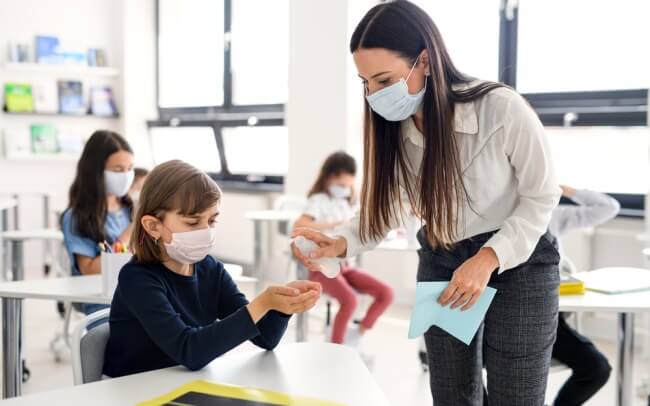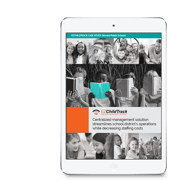
2020 may be over, but the challenges of COVID-19 remain. However, you can still maintain a safe workplace for your employees as well as safe childcare by taking a few steps to protect everyone, physically and financially.
How COVID-19 Spreads
According to the CDC and other resources, the country has learned that COVID-19 is primarily transmitted by respiratory droplets from someone infected with the SARS-CoV-2 virus, the virus that causes COVID-19.
The virus rides the droplets as they leave a person’s mouth or nose.
Respiratory droplets are spread not just by coughing and sneezing (although those spread the droplets farther) but also by whispering, talking, singing, and shouting. Droplets from an infected individual can land on other people nearby where they can become infected if the droplets land on their mouths or noses or if they inhale the droplets.
These droplets can remain suspended in the air momentarily, meaning there is still the danger of infection for a few seconds or minutes after an infected person leaves the area. Rarely, it is possible to become infected by touching a surface where droplets landed then touching your eyes, mouth, or nose directly afterward. Finally, there is new data about fecal-oral spread.
Voluntary Federal Guidance for Employee Protection
Both OSHA (Occupational Safety and Health Administration) and the CDC published voluntary guidance for employers to help protect employees. Employers are to encourage essential workers, those other than healthcare workers and first responders, to follow these recommendations:
- Increase physical distancing between people to six feet.
- Wear a mask. Recently, the guidance started to lean to double-masking in certain situations.
- Flexibility in when and where to work.
- Wash hands frequently.
- Cleaning and disinfecting facilities after a confirmed COVID-19 exposure.
- Offer flexible sick leave and childcare policies.
- Draft non-punitive emergency sick leave policies if no sick leave policy is in place.
- Employers should not require a positive COVID-19 test result or a healthcare provider's note to validate illness due to the overwhelming impact COVID has had on medical offices.
Most of these recommendations should sound familiar. The trick is to keep enforcing them and reminding people to remain aware of the potential for infection.
Keeping Everyone Safe
There are several steps you can take to maintain a safe and healthy childcare environment.
Survey Returning Workers for Concerns
Ask returning employees about their specific concerns and issues about returning to work. Even if you never closed, survey your administrators, teachers, and childcare staff about their thoughts on the safety of the workplace.
You may learn of problems you didn’t consider, and inviting employees to participate in communication and planning builds trust with those who are nervous about being at work. Ask open-ended questions and draw employees out about what they need to make them feel safe.
Ensure Accurate and Efficient Temperature Checks
Fever is a confirmed sign of many illnesses. If you check temperatures as people enter the facility, make sure you have enough staff and devices to measure everyone. Also, confirm that your temperature checking device is accurate.
If needed, modify your drop-off and pick-up procedures to stagger the number of people, including children, arriving at one time. Limit contact with parents and arrange for admins who do not provide childcare to work from home.
Change to outdoor drop-off and pick-up. If possible, have caregivers take the child directly from the car to reduce exposure by parents and children, and your staff. Always observe the children for signs of illness such as shortness of breath, flushed faces, and unexpected fatigue.
Have Employees Self-Certify
While you can check temperatures of your employees, children, and parents, you can also have your staff certify they are well before coming to work. Require everyone to complete a health questionnaire before leaving home. If your childcare solution has a portal for parents or employees, use that to provide the questionnaire and store the answers.
Also, consider building a roster of backup employees and substitutes. It might be difficult to find childcare workers, but having others to fill in is handy if you need to keep your facility open.
While at Work
The following is nothing you have not heard of, but it’s still the best way to get your business open and stay open while limiting the spread of the virus.
- Practice social distancing. Everyone should try to stay at least six feet apart, especially in classroom situations where everyone is exposed for an extended period.
- Everyone should wear a mask except for babies and children under the age of two. Yes, keeping masks on children is a challenge, but then, some grown-ups are challenged, too.
- Follow proper handwashing procedure. Wash hands with soap and water for at least 20 seconds. Make it fun by finding different songs to sing to help the time pass for the children.
- Use clear plastic barriers between staff and the public and on desks if possible.
- Keep children in the same groups all day and from day to day to limit exposure to more people. Limit mixing on the playground and in the lunchroom, too.
- Keep groups of children in separate rooms and prepare an “isolation room” for a child who becomes ill at school.
- Space out nap pads and cribs to six feet apart.
Ask your employees to point out ways to simplify these procedures and encourage them to point out problems.
Implement Cleaning Schedules
Stock up on cleaning supplies and create a schedule for cleaning various areas.
- Clean common areas, rooms, bathrooms, kitchens, handles, doors, and tablets hourly or between classes.
- Clean individual workstations overnight if admins work in the office.
- Clean surfaces between class sessions.
- Set aside toys with bodily fluid contamination to be cleaned before another playtime.
If a surface is soiled, wash it with water and detergent before disinfecting or sanitizing. Fortunately, books and other paper-based materials are not considered high risk for transmitting the virus, so there is no need for extra cleaning.
Reconsider Group Gatherings
Open house, holiday events, and special performances are part and parcel of childcare, but bringing families together just now isn’t a good idea. Instead, consider video recordings uploaded to a parent portal or your website and invite parents to view their child at a time convenient to them. Utilize Zoom or other conference video software to “meet” with parents or include a child who is too sick to come to childcare but not too ill to learn.
Support employees who must stay at home to isolate or quarantine by offering flexible sick leave. Provide resources to help them find care, and be sure to notify anyone who was in contact with a child or employee who tests positive for COVID-19.
Final Thoughts
The pandemic is the biggest challenge the world has seen in decades. But with diligence, you can safely serve your clients and children, providing the consistency we all need right now.




